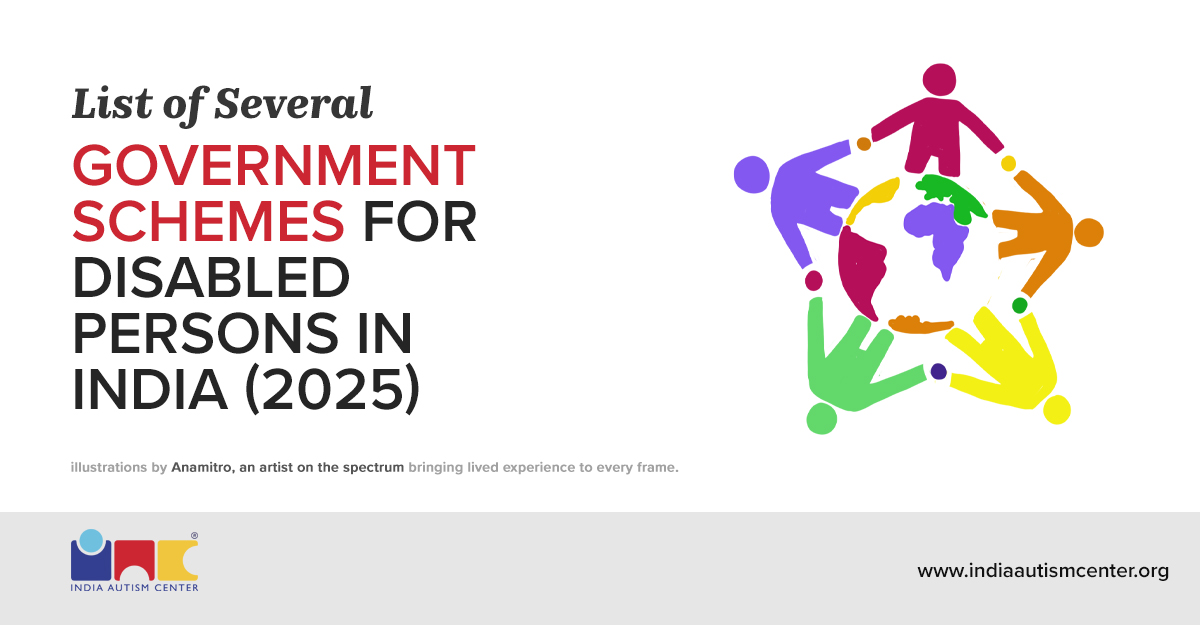For parents with children having autism in India, getting an autism disability certificate feels like navigating a maze of forms and hospital visits. Nonetheless, it is one of the most crucial steps in securing essential support and recognition following early detection and diagnosis.
Did you know that in 2021, it was found that about 1 in 127 people have autism? And in India, millions of children are diagnosed with ASD. Many of these children are eligible for government assistance, but only a fraction have an official disability certificate.
So wondering how to get an autism disability certificate in India? We have the answers for you.
Today, we will guide you through everything you need to know, from the process of applying for a disability certificate to obtaining the autism disability certificate in India via the UDID apply portal, including eligibility criteria and required documents, to help and empower autistic individuals.
What Is the UDID, and Why Is It Important?

First things first: what is UDID?
When you asked what UDID is, the answer is that it essentially stands for Unique Disability Identity. It is a national digital initiative by the Department of Empowerment of Persons with Disabilities (DEPwD), under the Ministry of Social Justice & Empowerment, Government of India.
Key highlights of UDID:
- A person with a disability can register and apply for a disability certificate on the UDID portal. It is quite simple to apply, track the application status, and request renewals and replacements.
- It helps create a centralised national database of PwDs to avoid duplicate entries, making the process transparent and streamlining benefit delivery.
- The allotted UDID card will be valid across all the states and union territories in India.
- As of 1 June 2021, according to a government notification, certificates issued through the UDID portal are to be the standard across all states/UTs.
How Can UDID Benefit People With Autism?
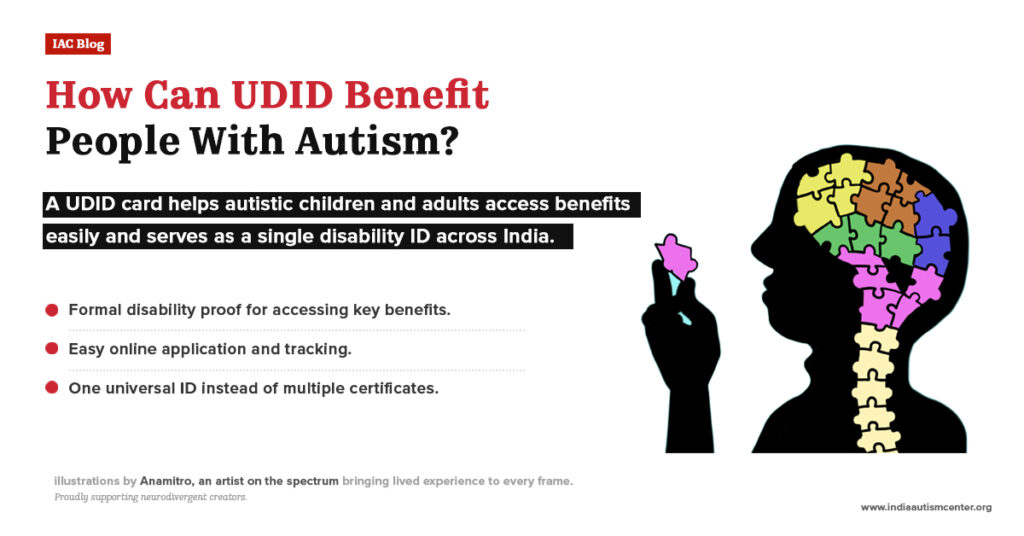
A UDID card is highly beneficial for children and adults recognised to have autism spectrum disorder (ASD) as per the RPwD Act. Here are the benefits of having a UDID card:
- Formal recognition of their disability, which helps in accessing schemes and concessions in education/railways/travel.
- Streamlined process (online registration, tracking) rather than wholly paper-based, manual processes.
- It becomes easier to present one documented identity for disability status rather than juggling multiple certificates.
So, a UDID card can make the “how to apply for a disability certificate” journey smoother and help to manage an autistic child’s behaviour in a better and more accessible way.
What Is the Eligibility for the Autism Spectrum Disability Certificate?
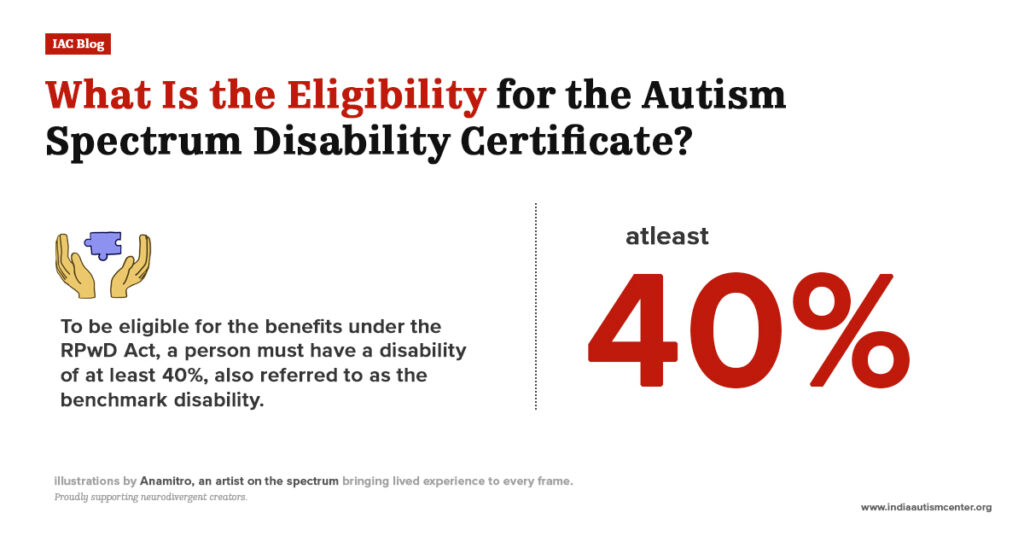
Under the RPwD Act, autism spectrum disorder (ASD) is one of the 21 specified disabilities. To be eligible for the benefits under the RPwD Act, a person must have a disability of at least 40%, also referred to as the benchmark disability.
Although autism spectrum disorder is included as per the Act, the severity and the functional impact will be assessed medically.
Who Can Apply for Autism Spectrum Disorder?

Before we get into the further details, here is the information that you need to know about who can apply for an autism spectrum disability certificate:
- Individuals diagnosed with ASD, or autism spectrum disorder, who are residing in India.
- For minors (children), the parent/guardian can apply on behalf of the child.
- For adults with ASD, they can apply themselves or via a guardian/representative (if applicable).
- The applicant must undergo the prescribed medical/psychological assessment and be recognised by a competent medical board/certification authority.
Some important things to keep in mind:
- Diagnosis alone is not enough; the disability certificate must be issued by the competent authority designated under the scheme.
- The certificate and UDID card are different but linked; hence, you should apply for both.
- The certificate may be for lifetime or temporary validity, depending on whether the disability is progressive or non-progressive.
Step-by-Step Guide: How to Apply for a Disability Certificate & UDID for Autism
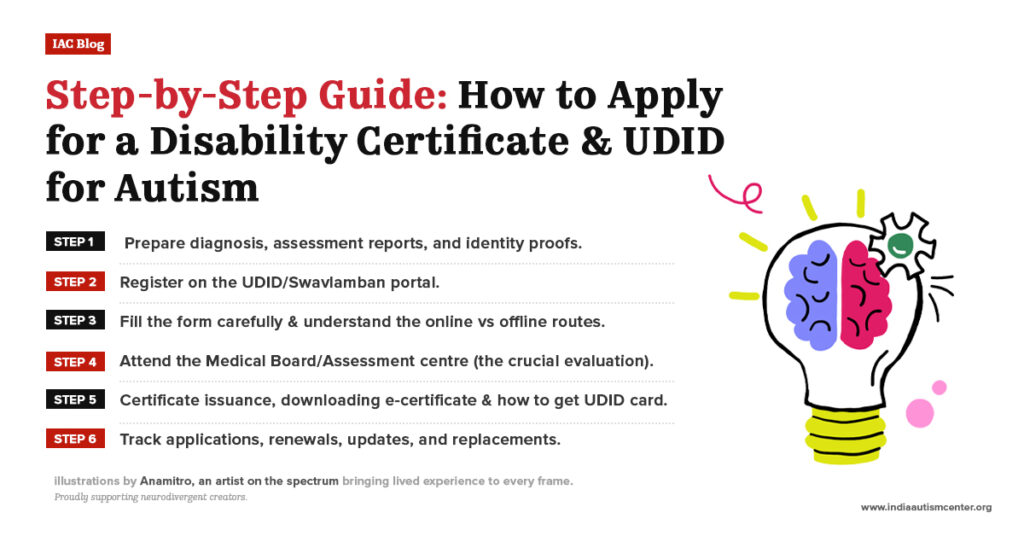
The application process for how to apply for a disability certificate for autism can be overwhelming at times. Hence, here are clear steps that can help you understand the procedure, paperwork, and practical tips for smooth processing:
Step 1: Prepare diagnosis, assessment reports, and identity proofs
This step involves collecting all necessary reports and proofs.
- Diagnostic report confirming Autism Spectrum Disorder (ASD) from a recognised specialist (paediatrician, psychiatrist, clinical psychologist, or neurologist). The report should be on hospital/clinic letterhead, with signature, registration number, and date.
- Functional assessment or developmental assessment results where available (Indian Scale for Assessment of Autism (ISAA), Vineland Social Maturity Scale (VSMS), Childhood Autism Rating Scale (CARS), or equivalent).
- Identity & address proof (Aadhaar, passport, voter ID, or other government ID). If Aadhaar is unavailable, another ID can be used.
- For a minor, a birth certificate is necessary.
- Passport-style photograph (digital upload & physical copy for the board).
- Any previous disability certificate or medical records/history (if applicable).
- School/therapy reports (for children: special education reports, speech therapy reports). It is a useful form of supporting documentation to demonstrate the functional impact on daily life, schooling, and communication.
Remember:
- Ensure that the diagnostic reports are both recent and legible.
- If assessments use paper tests, scan and save clear PDFs.
- Both physical copies and scanned copies must be kept ready for use.
Step 2: Register on the UDID/Swavlamban portal
- Visit the official UDID portal/Swavlamban portal. Look for the section “Apply for Disability Certificate & UDID Card” or “New Enrolment”.
- You can register by creating an account (email or mobile OTP verification). Use a parent/guardian’s mobile number or email for child applications.
- Fill in personal details accurately: full name, DOB, address, gender, guardian details (for minors), and Aadhaar if available (not strictly mandatory but recommended).
- Select the correct disability category and choose Autism Spectrum Disorder (ASD) when prompted.
- Upload scanned copies of the photo, identity proof, diagnostic report, and any assessment forms.
Remember:
- Save the enrolment/application number shown after submission, as you will need it to track the status.
- Some users prefer to save a screenshot of each upload step and the final confirmation page.
Step 3: Fill the form carefully & understand the online vs offline routes
Online process:
The portal typically guides you through the form fields. Common fields: demographic details, disability type, details of the diagnostic centre, uploaded reports, and declaration. Carefully type names exactly as per government ID to avoid mismatch issues at the Medical Board.
Offline process:
If you cannot apply online, many state-level social welfare offices, district disability cells, or government hospitals offer assisted/facilitated enrolment where staff fill the portal entries for you. Keep originals for verification.
Remember:
- Mismatch between the name on the Aadhaar and the application, or uploading blurred/partial documents (boards may reject or request resubmission).
- Using abbreviations inconsistently, spelling must match across ID/certificate; this inconsistency also needs to be avoided.
Step 4: Attend the Medical Board/Assessment centre (the crucial evaluation)
- The board will verify the identity documents and original diagnostic assessments.
- They will further perform a functional assessment to estimate how autism affects daily living (communication, social skills, and adaptive behaviour). The medical board for ASD typically includes paediatricians, psychiatrists, clinical psychologists, and/or neurologists, depending on the state and facility.
- The board may ask questions to the parent/guardian about milestones, communication, behaviour patterns, school performance, and therapy history.
- They may conduct or request additional tests (if the submitted reports are insufficient).
- The board will document the percentage of disability (if applicable) and determine whether the person meets the benchmark disability threshold (commonly 40% or higher) for benefits.
Remember:
- Carry all originals + 2–3 photocopies of each document (ID, diagnostic report, assessments, school reports).
- Please bring any assistive devices you use (e.g., hearing aids or communication devices, if applicable).
- For children, bring a familiar toy or comfort item and plan the appointment at a time when the child is calm.
- Bring a parent/guardian who knows the child’s developmental history and can answer questions about daily functioning.
Step 5: Certificate issuance, downloading e-certificate & how to get UDID card
Once the board approves, the issuing authority uploads the certificate details to the UDID portal. Now, how to get the UDID card? You will receive an approval notification (via SMS/email) with a link or enrolment reference.
- Log in to the portal with the help of your enrolment number and download the disability certificate (often in PDF/e-certificate format).
- The portal will also generate the UDID card (unique number and e-card). Many states issue an e-UDID immediately; physical UDID cards are sent later or can be printed locally.
Remember:
- Check name spelling, DOB, disability type (Autism/ASD), percentage (if stated), and validity. If anything is incorrect, please raise a correction request immediately via the portal or the relevant issuing authority.
Step 6: Track applications, renewals, updates, and replacements
Here are the steps that you can follow to track the status:
- Use the enrolment/application number on the UDID portal to see the status: Submitted → Document Verification → Medical Board Pending → Approved/Rejected.
- Some certificates are lifetime, while others (often for children or when a temporary assessment is done) have a validity period (e.g., 3 or 5 years). The certificate will clearly note the validity. Renew your plan at least one month before expiry, if required.
- The UDID portal allows users to update their personal details and request a replacement UDID card if it is lost/damaged. Use the “Update” or “Replace UDID” options and follow the verification steps.
Common Mistakes to Avoid
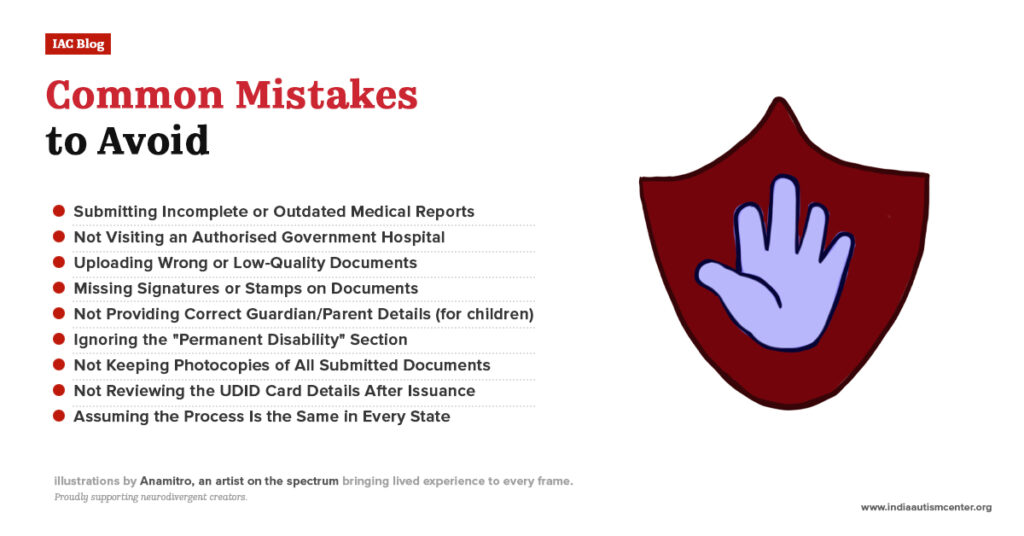
When you are applying for an Autism Disability Certificate or a UDID card, it can feel challenging. The good news? Most delays and rejections occur due to a few simple, avoidable mistakes. Understanding these beforehand can save you weeks of waiting and multiple hospital visits.
Below are the most common mistakes applicants make, along with detailed explanations to help you avoid them completely.
1. Submitting Incomplete or Outdated Medical Reports
Yes, one primary reason why applications get delayed is due to incomplete or outdated medical documentation.
Disability assessment teams require recent, complete, and standardised autism evaluation documents, especially tools such as ISAA (Indian Scale for Assessment of Autism).
Hence, ensure that all the reports are recent and up-to-date.
2. Not Visiting an Authorised Government Hospital
Visiting a private or a non-recognised hospital to get the reports can prove to be a mistake. Only government-certified medical boards are authorised to validate and issue a disability certificate.
Visit only district hospitals, government medical colleges, AIIMS, or state-run disability assessment centres. You can find it via the location tool on the UDID website.
3. Uploading Wrong or Low-Quality Documents
Incorrect file formats or blurry uploads can lead to rejection on the UDID portal. It is necessary to upload a clear and readable document. If it is not clear, it can get flagged by the system immediately.
Make sure that all documents are scanned clearly. Save it as a PDF, JPG, or another format that is within the supported size limit.
4. Missing Signatures or Stamps on Documents
A small detail, but one of the most common reasons for re-evaluation. Remember that unsigned reports are treated as incomplete medical evidence.
Ensure that you check every page for the doctor’s signature & hospital seal, and the assessment report has the official designation of the doctor.
5. Not Providing Correct Guardian/Parent Details (for children)
There can be verification issues if the parent details are mentioned incorrectly. The details must match the information on the Aadhaar card and birth certificate for correct authentication.
It is a best practice to double-check spellings, DOB, and ID numbers. Also, ensure that the parent applying is legally authorised as well.
6. Ignoring the “Permanent Disability” Section
Autism is classified as a lifelong neurodevelopmental condition, but many applicants mistakenly check “temporary disability”. If you select the temporary option, it can trigger yearly renewals and reassessments.
Always select ‘Permanent Disability’ when filling out UDID forms, since autism does not resolve with age.
7. Not Keeping Photocopies of All Submitted Documents
It might not seem important, but it is necessary to keep copies of all the hospital submissions. It will come in handy, especially if the hospital requests a resubmission.
Creating a folder and keeping all documents, along with UDID acknowledgement receipts, stored properly is a wise decision.
8. Delaying Follow-ups After Medical Board Assessment
Once the assessment is done, some applicants forget to track their status online. If any clarification is needed, delays can stretch for months.
Check your application status every 7–10 days on the UDID portal. Also, be sure to respond immediately if the portal indicates a document correction is required.
9. Not Reviewing the UDID Card Details After Issuance
Many people download the card without verifying details such as the disability percentage, name spelling, or date of birth. Any error requires a correction request, which takes additional weeks.
Verify each detail carefully, and if needed, apply for correction within 30 days of issuance.
10. Assuming the Process Is the Same in Every State
Each state has slight differences in hospital listings and scheduling of assessments. It is necessary to verify and follow the most recent guidelines to avoid any errors on your part.
Check your state-specific UDID instructions on the UDID portal for guidance. You should also confirm the hospital’s eligibility beforehand.
Conclusion
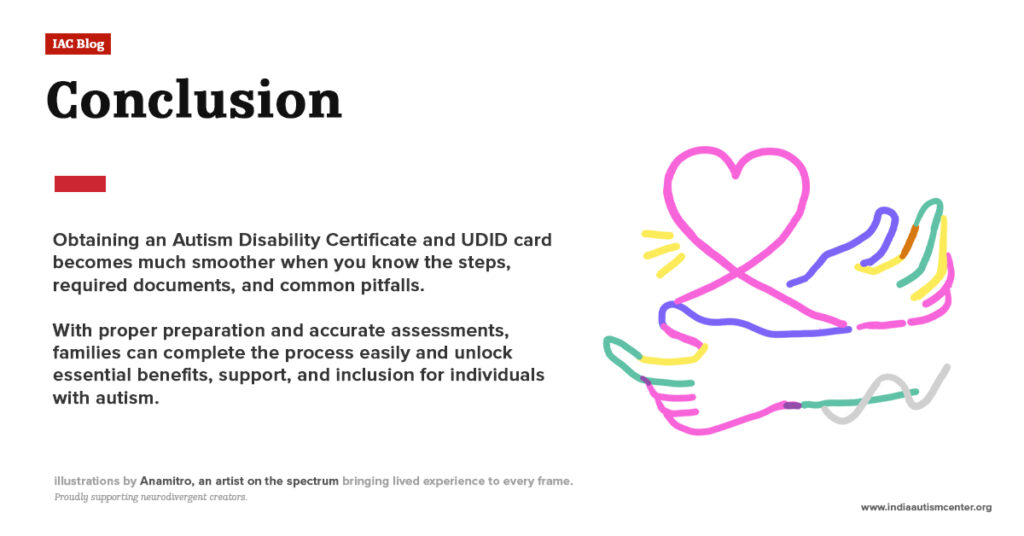
The process of obtaining an Autism Disability Certificate and UDID card in India can become easier if you are aware of the steps involved and the documents required and understand the common mistakes that cause delays. With the right preparation and accurate medical assessments, families can complete the process smoothly and unlock essential benefits, support services, and government schemes that ensure better access and inclusion for individuals with autism.
Frequently Asked Questions
What is an Autism Disability Certificate?
An Autism Disability Certificate is a government-issued document that officially recognises autism as a disability under the RPwD Act, 2016. It helps individuals access support services, education accommodations, financial benefits, and various welfare schemes.
How do I apply for a disability certificate online through the UDID portal?
You can apply by visiting the UDID portal, registering with your details, uploading the required documents, and booking a medical assessment. After approval, the digital UDID card can be downloaded from the portal.
How do I get a UDID card after receiving the disability certificate?
Once the medical board approves your disability, your UDID card is generated automatically. You can log in to the UDID portal, check your status, and download the digital card.
Can private hospital reports be used as part of the application?
Private reports may support the diagnosis, but the final assessment must be done at a government medical board. Only their evaluation is accepted for issuing a certificate.
For expert insights, support services, and inclusive learning initiatives, visit the India Autism Center.



